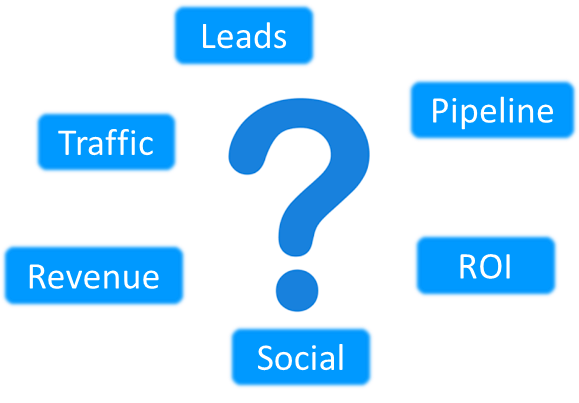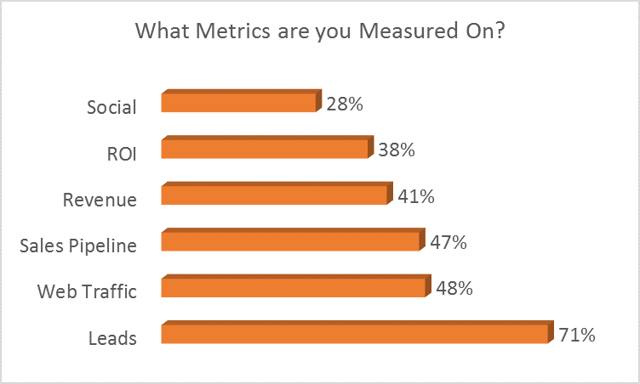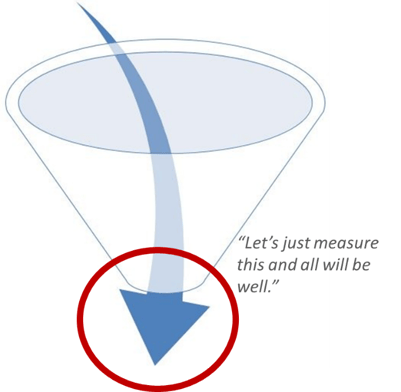Do you need to create a bonus plan for a B2B marketer?
Maybe you are considering a bonus based on how many leads they generate. That path is popular, but it’s difficult to implement in the industrial market place. There are even worse ideas, however, like paying for social media followers.
There is a tension between compensating your marketers for things that they can control – social reach, web site traffic and marketing qualified leads, versus things that you really want, like revenue.

This is a real challenge for industrial marketers because the sales cycles are so long and their tasks are so varied.
In this post we’ll assume that you already pay a competitive salary, so we will focus on incentive compensation for marketers.
There are all kinds of approaches, but be forewarned. If you pay for the wrong thing, you may get a whole lot of it. For example, if you compensate for website traffic your marketer can make sure that your site is busier than ever. Busy means little to your bottom line though if all those new visits are from unqualified visitors who are an ill fit for your product or service.
In this post we’ll investigate the primary ways that B2B marketers are compensated, and recommend specific ways to keep your marketing team aligned with your business objectives. We’ll also call out ways that marketers can game most of these metrics to earn their bonus even if their actual performance is poor.
There are Lots of Ways to Compensate Marketers
You can build a bonus program around just about any metrics. Here are some popular ones for engineering and industrial marketers:
- Lead generation
- Web site traffic
- Generating sales pipeline
- Revenue
- Return on Marketing Investment
- Social Media Reach / Engagement
In a 2017 survey of engineering marketers, we asked which metrics they were measured on.

The chart above comes from the Engineering Marketers 2017 Research Report. Two things should be readily apparent – One, the numbers don’t sum to 100%, indicating that many marketers are evaluated on more than one measure. Two, leads are currently…in the lead…for most popular metric.
In the balance of this post, I’ll assess the pros and cons of using each of these metrics to measure and compensate marketers, so that by the end of this post you’ll be able to craft an incentive plan that will work for your company.
Social Reach and Engagement
The chart above shows that relatively few marketers were measured on social reach and engagement, thankfully.
 Why do I say “thankfully”? We have all been told that social media is the best way to have genuine conversations with prospects and customers to develop brand loyalty. However, as the social media platforms switch from a free model to a paid model (how much have you budgeted for Facebook ads this year?), marketers are taking a harder look at social. What they are finding is that many social platforms are good for developing the top of their funnels, but not so much for activities that are closer to a purchase.
Why do I say “thankfully”? We have all been told that social media is the best way to have genuine conversations with prospects and customers to develop brand loyalty. However, as the social media platforms switch from a free model to a paid model (how much have you budgeted for Facebook ads this year?), marketers are taking a harder look at social. What they are finding is that many social platforms are good for developing the top of their funnels, but not so much for activities that are closer to a purchase.
And when you reward for social activities, what will you measure? Number of followers? Number of tweets? I hope not. Measuring shares is potentially interesting, because shares indicate the number of people who have liked your content enough to endorse it to their friends and followers.
Some of you may be wondering about “likes”, as on Facebook, Twitter, or Instagram. I’m not a fan of measuring likes for industrial marketers. Likes are too easy to game. You can simply take a small advertising budget and target it at geographies where people have a high propensity to click. They are also easily gamed by having images that don’t reflect your actual product or service but resonate with people on a purely emotional level – think puppies or kittens. So far, I haven’t seen any industrial marketer stoop so low as to put a basket of puppies on a machine tool, but that would probably drive activity on social media. This is not where you want your industrial marketing to go.
Why Measuring Web Traffic is Both a Good and Bad Idea
Measuring web site traffic is a good idea because most of your prospects will visit your web site to gather information at some point in their buying journey. That is why almost half of all marketers (48%) are measured on this metric.
Traffic to your web site is terrifically valuable if it is the result of an engineer searching for a specific type of product or an answer to a particular problem. This is all “good traffic” and the result of your team’s content marketing strategy and SEM efforts.
The problem is that not all traffic is good traffic. At ENGINEERING.com we use traffic as a metric for our marketing team. To avoid the problem of irrelevant traffic, I’ve started using Organic Search Traffic as a key metric to determine whether the visits we see are from the right audience. Another way to make sure that you are getting the right traffic is to measure the visits to the most relevant pages on your web site, such as those pages that are clearly supporting a buying journey.

The other thing we track is organic search rankings on our most important keywords. We use SEM Rush for that, but there are many other tools in that category that will tell you how you are performing. If you have a content marketing team, you will likely also want to measure and reward other engagement metrics such as time on site and bounce rate.
Best practice: If you measure and reward on web site traffic, make sure to find a way to sort out the right kind of traffic from the wrong sort, and reward only the valuable traffic. Consider rewarding based on keyword rankings as well.
The Attraction of Paying your Marketer for Generating Leads
It’s clear that the main job of marketing is to bring qualified leads to your sales team. The rest of the work that the marketing team does is all to that end, including preparing marketing collateral, running awareness campaigns, organizing events, and running your content marketing activities. Since these things are all in support of generating leads, doesn’t it make sense to just measure the outcome and pay incentives for that? That approach has the attraction of letting you stay away from the mess of measuring and rewarding all of the precursor activities.
Here is a typical approach. Let’s say your sales team has a close rate of 25%, which is to say that out of all the leads they receive, they close one out of every four. Right now they are getting 400 leads per quarter, and winning 100 new deals. You decide that if your marketing team can increase that figure to 500 leads in a quarter, your sales team will close 125 deals and all will be well.
500 leads x 25% Close Rate = 125 Sales
If you put that incentive program in place the most likely outcome is that you will get 500 leads, but that the sales team will close fewer than the previous mark of 100. That’s right. The most common outcome is that sales will actually go down. Why? It’s because the marketer took you at your word. She redirected her budget to activities that would drive leads – creating content assets and buying email blasts, and pressed GO. When she was 200 leads short at the end of the quarter, she ran a campaign on a generic and inexpensive lead generation service that will push your content far and wide for a low fee of $20 a lead, but does little to ensure alignment with your product.
Once these leads were in the hands of the sales team, they proved to be unqualified. The result is that your marketer hit her target, but the sales team spent more time chasing unqualified leads and actually ended up closing fewer deals.
The other unfortunate outcome from such an arrangement is infighting between Sales and Marketing, causing stress and reducing performance overall. When marketers are focused on lead volume, inevitably a rift opens up about how qualified the leads actually are, with Sales saying “why does marketing keep sending us crappy leads?” and Marketing saying, “why can’t those sales people follow up with the leads we send?”. This got so bad at one of our clients that the sales team actually ignored a large subset of the leads that Marketing sent. And by “ignored”, I mean no follow up. Zero. What a waste.
To Fix Lead Generation, You Need Agreement Between Marketing and Sales
That doesn’t mean measuring on leads is a bad idea. It is, at 70%, the most common way to measure and reward industrial marketers.
However, there is a critical key to making this work, and that is to get an agreed definition of a lead and when it will be passed to the sales team. And by agreed, I mean agreed between Marketing and Sales. That definition needs to include industries that you are targeting, geography, and what level of contact information the person provides. Ideally, it includes an agreement on the level of interest the prospect has shown. If your sales team says that they only want prospects near the bottom of the funnel, such as those who have asked for a quote, you will need to set up lead nurturing and provide more budget to marketing to do that job.
Here is a popular post on four steps to better alignment between sales and marketing.
Best practice: Make sure that there is an agreed definition of leads between Marketing and Sales and count only those leads that qualify.
Is Revenue the Best Way to Reward Industrial Marketers?
We have seen an increase in the number of marketers who are measured on helping their sales teams generate actual revenue. Surely this is a good thing. Rewarding on revenue creates tighter alignment between Sales and Marketing and motivates marketers to do the exact thing that most benefits the company.
Or does it?

One of our customers is a marketer for engineering software. His primary measurement is revenue and he is measured quarterly. Wait. What?
Yes, you read that right. He has a quarterly revenue objective for a product that has a sales cycle of anywhere from 3 months to 3 years. There is virtually nothing that he can do in any quarter, short of selling more seats to existing customers, that will influence his primary performance metric. To make matters worse, the reward structure leans heavily towards new accounts, making for a serious disconnect between his actual performance and his incentive structure.
This highlights two problems with paying marketers based on revenue:
- Sales cycles for industrial marketers are too long to measure quarterly
- Focusing all efforts on revenue leads to short-term thinking and reduces focus on top of funnel activities that are critical for achieving long-term revenue goals
Best practice: Only reward on revenue if your company’s products have a short sales cycle, and even then, consider a longer time horizon than quarterly.
Sales Pipeline is one of the Best Measures of Marketing Success
Sales Pipeline is another marketer metric that has increased in popularity in recent years, now standing at 47% of all marketing teams. Pipeline is typically defined as the amount of revenue that a salesperson enters into their CRM system (think Salesforce.com) as a forecast associated with a lead. For those leads that come from the marketing team, the pipeline that would be counted would be the amount of forecast revenue that came from those leads.
Note that pipeline is typically not discounted by the probability of the salesperson closing a sale. Instead, it is the amount that a salesperson enters into their own forecast as an opportunity after they have qualified the lead.
This step of the salesperson qualifying the lead is a critical point. This validation step ensures that the marketer has passed along a lead that meets the sales definition rather than simply having the right contact fields filled in on a form.
You may be thinking, “This sounds great and we even have the tools to measure it.” I would caution you against relying only on this metric, however. It still focuses too much attention on the bottom of the funnel. Also, an excessive focus on sales pipeline overly rewards a marketer for seeking and finding prospects who are already in a buying cycle rather than building the brand and nurturing customers.
Best practice: Sales pipeline is a useful metric. Use it in combination with top-of-funnel measurements such as selected web site traffic, and you can build an incentive program that is well aligned with your business objectives.
Measuring Marketing ROI is Awesome, but Difficult
More than a third of engineering marketers (38%) say are being measured on Return on Marketing Investment. This is a wonderful, but difficult, thing to do.
If you can truly measure your marketing ROI, and you can prove that a campaign is generating qualified leads that turn into real marginal earnings, then your business absolutely should increase its marketing budget to do more of that type of campaign. The additional sales that come from the successful campaign will provide the additional marketing budget you need.
Here is the hard part. To calculate the actual return on a campaign, marketers must know not only the revenue that comes from the campaign, but also the value to the company for each dollar of revenue. This means that marketers need to know the cost of the products that are sold including the sales and distribution costs. That is often not the case.

Even if you do have a good cost estimate, few campaigns result in a direct and measurable connection to earnings. After all, industrial marketers are responsible for complex products like enterprise software and factory automation, not cans of soup. There are just too many steps and nuances in an industrial sale to tease out exactly what campaign led to revenue, particularly if the sales cycle is long.
That leads marketers to develop derivative measurements, such as the value of a lead or even the value of a web site visitor, and then create ROI based on these derivative metrics. Unfortunately, as you move further away from actual real earnings, the quality of the metrics decline unless you are very rigorous about the definition of each of these intermediate steps.
Another risk is that many marketing automation systems have trouble identifying where a lead came from. It may be based on first touch, last touch or a formula, making it difficult to attribute actual leads, pipeline or revenue to the correct source.
Best practice: If you can truly measure Marketing ROI, then it is a wonderful metric for rewarding your marketer. But if you are relying on derivative measurements for ROI, make sure that the elements of your formula are real.
So How do you Measure and Reward Industrial Marketers?
I recommend a complex measurement and reward system that includes some percentage of compensation for each stage of the buyer’s journey, from awareness to pipeline. As you can see from the bar chart at the start of this post, while 70% of marketers are measured on leads, a large number are measured on multiple items. This complexity of measurement is a natural result of the increased maturity of industrial marketing.
To make this work at your company, you can adjust the percentages to match the marketer’s role and even set some specific targets, such as getting three case studies published.
If there are incentives for each of awareness, consideration and pipeline, and if there is good alignment between marketing and sales on the definition of leads and/or pipeline, your compensation model should work well.
I would love to hear your thoughts on compensating marketers in the comments section. Also, if you are considering nurturing your leads further before passing them to your sales team, here are a couple of additional pieces:
How to Nurture your Engineering Leads so they are Ready for SalesAn Engineering Marketers Guide to Lead Nurturing
Thanks for reading and sharing,
John




